|
|
July-August
Lambing
( late pregnancy on green feed) |
 |
The optimum profile for spring lambing flocks in the Medium Rainfall Zone (Great Southern) in WA is:
- to allow moderate loss of condition from joining to day 90, provided the condition can be regained prior to lambing on green feed
- aim for Condition Score 3 at joining
Ewes can lose some condition (0.4 of a condition score) over early pregnancy (Figure 1), however, they must
regain all condition lost in early pregnancy by lambing.
Failing to meet this lambing target will decrease the value of the ewe's production by $11 per condition score. It costs at least $16/ewe to gain a condition score with grain feeding. Therefore gaining condition must be done with green feed. See Figure 2 for the impact on profit as well as survival of twin lambs.
This lose and regain profile is more profitable than other profiles due to
a lower supplementary feed bill over autumn, better use of emerging pasture and that there is a compensatory gain effect on lamb survival if ewes increase their condition in the last 1/3 of pregnancy.
Figure 1.
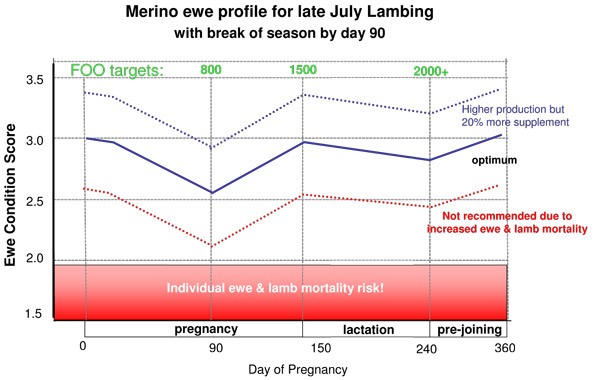
(click on the image for a printable version)
Ewes require 800kg/ha FOO by day 90 and 1500 FOO by lambing to regain lost condition. If this amount of green feed isn't likely to be available then the next best approach is to maintain ewe condition throughout pregnancy. Establishing pastures should be deferred so that FOO targets can be reached.
Aiming for a condition score (CS) of 3 for the joining period not only gives a reasonable reproductive rate (# of lambs per 100 ewes) but also sets up the likely condition ewes can achieve by lambing, allowing for some loss over autumn, once joining is complete.
Cost of not following the profile
If the regain in condition by lambing isn't made and the ewes continue to lose condition in late pregnancy to near CS 2, large penalties from ewe and lamb mortality will be incurred (Figure 2).
Even maintaining condition in late pregnancy after losing condition in early pregnancy will have an impact on lamb survival, particularly with twin lambs. Any individuals in the mob at or below CS2 will be at higher risk.
Maintaining ewes at their joining condition throughout pregnancy is expensive (approximately $2.50/ewe compared to losing and regaining) due to the extra hand feed over autumn.
However, this option is still more profitable than allowed to lose condition and fail to regain it in the last third of pregnancy.
If ewes are allowed to lose over autumn but only maintained in condition after day 90 (rather than re-gaining condition), there will be a reduction in profit per ewe of at least $4.00 compared to the optimum (figure 2). This could be as much as $40,000 on a 1000ha enterprise!
Figure 2.
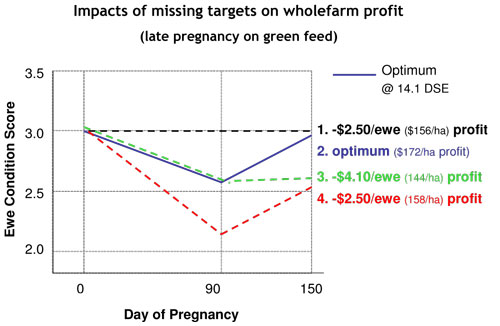
Profile 1. Profit is lower due to higher supplementary feeding costs
Profile 2. Optimum due to lower feeding in early pregnancy and regaining condition on green feed
Profile 3. Profit is lower due to impacts from lower condition at lambing
Profile 4. Lower lambing target limits profitability
Running lower Stocking Rates
These profiles are also suitable for flocks run at stocking rates lower than the optimum.
However, following the lifetimewool ewe profile can allow you to increase stocking rates safely and thereby increasing profitabilty.
In years that ewes' peak condition prior to joining is above 3, it is worthwhile following the higher profile as described in Figure 1 (ie. joining in CS 3.4. losing to CS 3.0 and regaining to CS 3.4 by lambing) for that season because extra productivity will result.
Continuing to run ewes at this higher flock condition score will give a similar profitability to runninng ewes at the optimum profile, as the higher production gains are offset by the higher cost of supplementation.
Aiming to be on this profile every year or in an average year will be slightly more expensive as it takes more supplement to grow maiden ewes to the higher starting condition score.
Trade-offs of risk for profit
The July lambing optimum profile shown in Figure 1. takes into account both profitability and the health of the breeding flock. The 2 alternative profiles shown offer similar levels of profitability, but there are some important trade-offs to consider.
Ewe mortality generally increases with lower ewe condition by lambing (there are other factors such as weather, age and available feed). Ewe condition in late pregnancy has a large impact on lamb birth weight and therefore lamb survival.
There is a compensatory gain effect on lamb birthweight when ewes that have lost condition regain it in late pregnancy. Twin lambs are more sensitive to this change in birth weight (& survival) as their birthweight is usually further from the optimum.
Table 1 shows the effect of several profiles on both lamb and ewe survival.
Table 1. Difference in survival of ewes and lambs compared to maintaining condition throughout pregnancy,
in a late July lambing
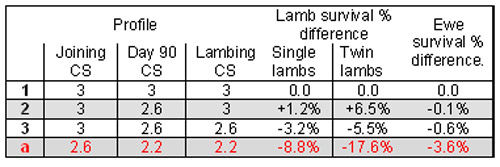 
Following a lower, but similar shaped profile (profile 4) to the optimum (profile 2) means that at day 90, the flock average will be CS 2.2. The mob will require careful monitoring and if the mob fails to regain condition to 2.6 by lambing severe penalties in ewe and lamb mortality will result.
Profile 5 in Table 1 shows that twin lambs have a predicted decrease in survival of 17%!
This can be compared to the optimum profile which can increase twin lamb survival by 6.5%.
As well as this, individuals in the mob will be below the recommended CS 2 for pregnancy and at risk of mortality.
Getting it wrong when following the lower profile will impact on acceptable stock husbandry as well as profitability.
The Condition Score profile is for the average of the flock. Usually in each flock there will be some individuals at least 0.5 of a condition score lower (and an equal proportion that are 0.5 of a condition score higher).
Individual ewes should not be below CS 2. Ewes at or below CS 2 during pregnancy should have preferential treatment to regain condition prior to lambing as ewe (as well as lamb) mortality increases dramatically when ewes are below CS 2.
Download the full MIDAS economic analysis report (250kBs pdf)
back to top
May Lambing
(late pregnancy on dry feed)
The profitability of early lambing flocks is at least half that of later lambing flocks for a merino enterprise ($68 compared to $172).
This is due to lower stocking rates and a poorer match of pasture feed to animal demand.
The optimum profile for May lambing flocks in the Medium Rainfall Zone (Great Southern) region is:
- to allow moderate weight loss from joining to day 90 and then maintenance of weight through to lambing.
- aim for CS3.0 or above at joining
- aim for no lower than CS 2.6 by lambing
It is not profitable for ewe flocks to regain weight prior to lambing because the only feed available to achieve this is grain and it is too expensive.
Figure 3.
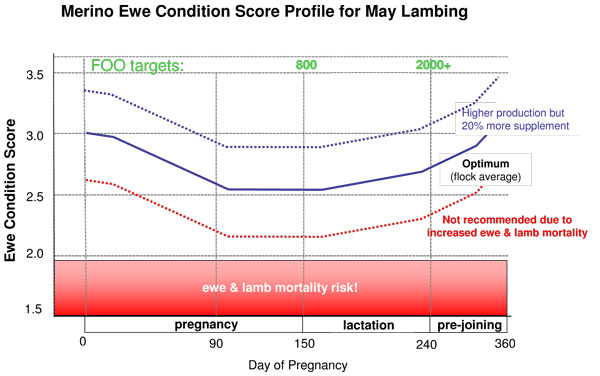
(click on the image for a printable version)
Cost of not following the profile
If ewe flocks lamb in less than CS 2.2, large penalties will be incurred.
Ewe and lamb mortality, lost wool production from both the ewe and the progeny far out way the saving on supplementary feed.
10% lower returns will be achieved if ewes are maintained throughout pregnancy from their peak condition in summer compared to controlled weight loss post joining to a minimum of CS 2.6.
(Figure 4).
Figure 4.
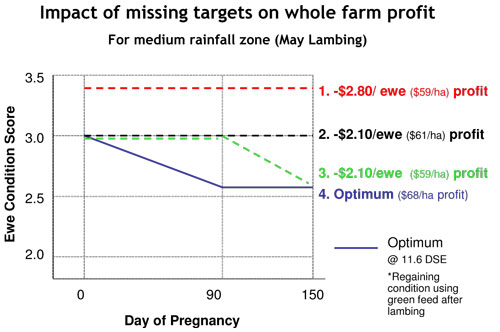
Profile1. Profit is lowest due to high supplementary feeding costs
Profile 2. Profit is lower than optimum due to supplementary feeding costs
Profile 3. Profit is lower than optimum due to losses ewe and lamb production
Profile 4. Optimum profile due to lower feed costs but limited losses in production
Benefits exist if ewes lose weight from joining to day 90 and are fed to maintain that condition before lambing. It may be worth considering feeding extra grain from day 90 (to allow up to 0.4 CS) if the ewe's condition has been allowed to slip lower than the recommended lambing target.
Running lower Stocking Rates
These profiles are also suitable for flocks run at stocking rates lower than the optimum.
However, following the lifetimewool ewe profile can allow you to increase stocking rates safely and thereby increasing profitabilty.
In years that ewes' peak condition prior to joining is above 3, it is worthwhile following the higher profile as described in Figure 1 (ie. joining in CS 3.4. losing to CS 3.0 and maintaining condition to lambing) for that season because extra productivity will result.
Continuing to run ewes at this higher flock condition score will give a similar profitability to runninng ewes at the optimum profile, as the higher production gains are offset by the higher cost of supplementation.
Aiming to be on this profile every year or in an average year will be slightly more expensive as it takes more supplement to grow maiden ewes to the higher starting condition score.
Trade-offs of risk for profit
The May lambing optimum profile shown in Figure 1. takes into account both profitability and the health of the breeding flock. The
alternative profile shown offers similar levels of profitability, but there are some important trade-offs to consider.
Ewe mortality generally increases with lower ewe condition by lambing (there are other factors such as weather, age and available feed). Ewe condition in late pregnancy has a large impact on lamb birth weight and therefore lamb survival. Twin lambs are more sensitive to this change in birth weight (& survival) as their birthweight is usually further from the optimum.
Table 1 shows the effect of several profiles on both lamb and ewe survival.
Table 1. Difference in survival of ewes and lambs compared to maintaining condition throughout pregnancy for a May lambing

The Condition Score profile is for the average of the flock. Usually in each flock there will be some individuals at least 0.5 of a condition score lower (and an equal proportion that are 0.5 of a condition score higher).
Individual ewes should not be below CS 2. Ewes at or below CS 2 during pregnancy should have preferential treatment to regain condition prior to lambing as ewe (as well as lamb) mortality increases dramatically when ewes are below CS 2.
Download the full MIDAS economic analysis report (250kBs pdf)
back to top
|